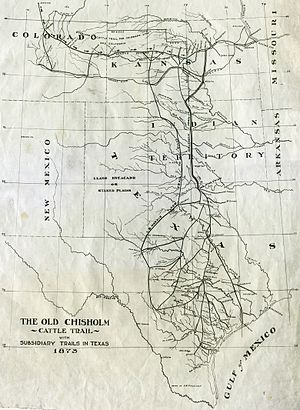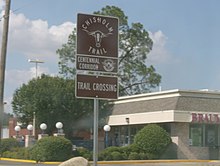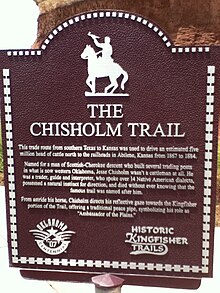Kelly Family in Caldwell, Sumner Co, Ks, 1885

The Chisholm Trail was a trail used in the post-Civil War era to drive cattle overland from ranches in Texas to Kansas railheads. The trail was established by Black Beaver, a Lenape guide and rancher, and his friend Jesse Chisholm, a Cherokee merchant. They nerveless and collection numerous cattle along the trail to Kansas, where they could be shipped eastward to accomplish college prices. The southern terminus was Red River Station, a trading post near the Blood-red River forth the northern border of Texas. The northern terminus was a trading mail service near Kansas City, Kansas. Chisholm owned both of these posts. In the years of the cattle drives, cowboys would drive big herds from ranches across Texas to the Red River Station and then north to Kansas City.
Overview [edit]
Texas ranchers using the Chisholm Trail had their cowboys start cattle drives from either the Rio Grande area or San Antonio. They joined the Chisholm Trail at the Red River, at the border between Texas and Oklahoma Territory. They continued n to the track head of the Kansas Pacific Railway in Abilene, Kansas, where the cattle would be sold and shipped eastward. The trail is named for Jesse Chisholm, a multiracial trader from Tennessee of one-half Cherokee descent. Together with scout Black Beaver, he adult the trail to transport his appurtenances from one trading post to another. The ii men were the get-go to drive cattle north along this route.[1]
Business aspects [edit]
By 1853, Texas cattle were being driven into Missouri. Local farmers began blocking the herds and turning them dorsum because the Texas Longhorns carried ticks that acquired diseases in other species of cattle. Violence, vigilante groups, and cattle rustling caused further problems for the drovers. Past 1859, the driving of cattle was outlawed in many Missouri jurisdictions. By the finish of the Civil War, most cattle were beingness moved upwards the western branch of trail, being gathered at Red River Station in Montague County, Texas.
In 1866, cattle in Texas were worth $four per caput, compared to over $40 per caput in the Due north and East. Lack of market access during the Civil War had produced an overstock of cattle in Texas. In 1867, Joseph G. McCoy congenital stockyards in Abilene, Kansas. He encouraged Texas cattlemen to drive their herds to his stockyards. O. W. Wheeler answered McCoy'south call, and he along with partners used the Chisholm Trail to bring a herd of 2,400 head from Texas to Abilene. This herd was the showtime of an estimated 5,000,000 head of Texas cattle to reach Kansas over the Chisholm Trail.[2] [iii] McCoy's stockyards shipped 35,000 head in 1867 and became the largest stockyards west of Kansas City, Kansas.
The construction of the Union Pacific Railway through Nebraska eventually offered a cattle drive destination that was an attractive alternative to the Kansas Pacific Railroad. The Texas Trail emerged as an alternative to the Chisholm Trail. Between 1876 and 1884 some drives went forth the Texas Trail instead of the Chisholm Trail.[iv]
Road [edit]


In Texas, hundreds of feeder trails headed north to 1 of the main cattle trails. In the early 1840s, most cattle were driven upward the Shawnee Trail. The Chisholm Trail was previously used by Indian hunting and raiding parties; the trail crossed into Indian Territory (present-solar day westward-key Oklahoma) nigh Red River Station and entered Kansas near Caldwell. Through Oklahoma, the road of U.S. Highway 81 follows the Chisholm Trail through present-twenty-four hours towns of El Reno, Duncan, Chickasha, and Enid.[five]
Historians consider the Chisholm Trail to take started either at Donna or San Antonio. From 1867 to 1871, the trail ended in Abilene, Kansas, but every bit railroads incrementally built southward, the terminate of the trail moved to other cities. The stop of the trail moved to Newton and soon later on to Wichita. From 1883 to 1887, the end of the trail was at Caldwell.
Challenges [edit]
On the long trips—up to 2 months—the cattlemen faced many difficulties. They had to cross major rivers such every bit the Arkansas and the Reddish and innumerable smaller creeks, too as handle the topographic challenges of canyons, badlands and low mount ranges. The major drives typically needed to start in the spring after the rains stimulated the growth of dark-green grasses for the grazing cattle. The spring drives, with those rains and college water levels with the runoff, always meant more danger at the river crossings, which had no bridges. The half-wild Texas Longhorn cattle were contrary and decumbent to stampede with little provocation.
The days of longest sunlight, nearly mid-June, were also an important consideration in the timing of drives. In addition to natural dangers, the cowboys and drovers encountered rustlers and occasional conflicts with Native Americans. The cattle drives disrupted the hunting and cultivation of crops in Indian Territory. Tribal members demanded that the trail bosses pay a toll of ten cents per head to local tribes for the right to cross Indian lands (Oklahoma at that time was Indian Territory, governed from Fort Smith, Arkansas).
The only adult female known to run her own cattle bulldoze traveled from Texas to Wichita using the Chisholm Trail. Margaret Borland took her family, hired hands, and two,500 Longhorns through the trail in 1873 in search of profit for her cattle, which was worth triple in Kansas over Texas prices. She died from what was called trail fever but later arriving in Wichita, after an otherwise successful journey.
Representation in media [edit]
The cattle drives have been a popular topic amidst Western genre movies. At to the lowest degree 27 movies accept portrayed fictional accounts of the first drive forth the Chisholm Trail, including The Texans (1938), directed past James P. Hogan and starring Randolph Scott and Joan Bennett; and Red River (1948), directed by Howard Hawks and starring John Wayne and Montgomery Clift. Walter Brennan co-starred in both films.
The trail is the subject of at least ii pop songs: "The Final Cowboy Song," written and recorded by Ed Bruce, also performed by The Highwaymen; and the song "The Erstwhile Chisholm Trail." Among those who have covered the song are Gene Autry, Girls of the Golden Due west, Woody Guthrie, Michael Martin Murphey, Tex Ritter, and Roy Rogers. Lead Belly (Huddie Ledbetter) besides covered this song, although his version was titled "When I Was A Cowboy". Nova Scotia-built-in Wilf Carter recorded a version of the song, titled, "Come A Ty-ya Yippie Yi Yo".
Legacy [edit]
In 1964, Texas rancher Charles Schreiner III founded the Texas Longhorn Breeders Clan of America. The adjacent year, he conducted a cattle drive from San Antonio to Dodge Urban center with a stop at the LBJ Ranch in Gillespie County, dwelling house of U.S. President Lyndon B. Johnson. The drive was promoted as a centennial commemoration of the original Chisholm Trail drives.[6]
Many schools in this region accept been named afterward the Chisholm Trail, including:
- Chisholm Trail High School in Fort Worth, Texas
- Chisholm Trail Centre School in Olathe, Kansas[7]
- Chisholm Trail Eye Schoolhouse in Round Rock, Texas
- Chisholm Trail Eye School in Rhome, Texas[8]
- Chisholm Trail Uncomplicated School in Park City, Kansas[9]
- Chisholm Eye School in Newton, Kansas
- Chisholm Trail intermediate schoolhouse in Keller, Texas
- Chisholm High School in Enid, Oklahoma
- Chisholm Elementary School in Edmond, Oklahoma
- Chisholm Trail Elementary School in Sanger, Texas[ten]
The Chisholm Trail is roughly traced by U.S. Route 81 through Oklahoma, and that state has multiple museums and sites paying respect to the trail.[11] The Chisholm Trail Heritage Center in Duncan, Oklahoma has educational and interactive exhibits, a large monument depicting a scene from a Chisholm Trail cattle drive, and a trail walkway.[eleven] [12] Trail Ruts at Monument Hill just exterior of Duncan has visible traces of cattle hoofs and wagons actually left on the trail.[11] Kingfisher, Oklahoma, has a life-size statue of Jesse Chisholm in the middle of downtown, as well as the Chisholm Trail Museum and Governor Shea Mansion which gives a clear timeline of the trail.[xi] Yukon, Oklahoma, has the Chisholm Trail Watering Pigsty and celebrated marker, while Jesse Chisholm's gravesite is a chip farther northward outside Geary, Oklahoma.[xi] A landscape in Enid, Oklahoma depicting the trail is located in the downtown expanse.[xi]
Lockhart, Texas, in Caldwell County, holds a four-solar day festival on the 2d weekend of June, to gloat its place on the Chisholm Trail. Newton, Kansas holds a three- to four-day Chisholm Trail Festival, combining it with the annual 4th of July commemoration. On September 26, 2009, a historical marker on the Chisholm Trail was unveiled at the site of Red River Station in Montague County. The 5.5-foot concrete marker is the last of 12 erected in Montague Canton every bit role of a joint projection of the Texas Lakes and Trails and the Montague County Historical Committee to define the Chisholm Trail in this surface area (as said in Wichita Falls Times Record News).
In 2014, the Due north Texas Tollway Authority constructed a 26-mile-long toll route named afterwards the trail, the Chisholm Trail Parkway. It connects downtown Fort Worth to the nearby city of Cleburne in Johnson Canton. In 2017, the Texas Historical Committee released The Chisholm Trail: Exploring the Folklore and Legacy, an online tour and mobile app.[xiii] The tour includes audio tracks and short videos that retell the history of communities and local heritage in towns and cities that line the road of the former Chisholm Trail.
References [edit]
- ^ C., RICHARDSON, T. (12 June 2010). "CHISHOLM, JESSE". tshaonline.org . Retrieved 4 April 2018.
- ^ Worcester, Donald Eastward.: "Chisholm Trail" from the Handbook of Texas Online. Retrieved December 23, 2008.
- ^ Dortch, Steven D. "Chisholm Trail". Encyclopedia of Oklahoma History and Civilization - Oklahoma Historical Club. Archived from the original on November xix, 2012. Retrieved Nov 11, 2012.
- ^ "The Texas Trail".
- ^ Oklahoma Map of Chisholm Trail Oklahoma State University Digital Library Collections
- ^ Douglas Martin (Apr 29, 2001). "Charles Schreiner Three, 74, Dies; Colorful Texas Rancher Fought to Save Longhorn". The New York Times . Retrieved Oct 16, 2015.
- ^ "Chisholm Trail Heart School". schools.olathe.k12.ks.us . Retrieved four Apr 2018.
- ^ "Home - Northwest Independent School District". www.nisdtx.org . Retrieved 4 April 2018.
- ^ "Chisholm Trail Elementary / Homepage". chisholmtrail.usd259.org . Retrieved 4 April 2018.
- ^ https://cte.sangerisd.cyberspace/
- ^ a b c d due east f "Chisholm Trail left its mark on Oklahoma". Dino Lalli, Tulsa World, November 16, 2020. Retrieved November 16, 2020.
- ^ Chisholm Trail Heritage Center Chisholm Trail art, culture, and history - Duncan, Oklahoma
- ^ "The Chisholm Trail: Exploring the Sociology and Legacy". Texas Travel . Retrieved 4 April 2018.
Further reading [edit]
- Guide Map of the All-time and Shortest Cattle Trail to the Kansas Pacific Railway; Kansas Pacific Railway Company; 1875. (Read Online)(Map)
- Morality and Money: A Await at how the Respectable Community Battled the Sporting Community over Prostitution in Kansas Cowtowns, 1867-1885; Jessica Smith; Kansas State University; 2013. Read Online
External links [edit]
- The Texas Historical Commission Chisholm Trail mobile tour
- History on the trail from the "Kansas Heritage Group"
- Upward the Chisholm Trail by the Williamson Canton Historical Commission
- Along the Chisholm Trail Web site with maps, history, monuments, and guides for visiting.
- The Chisholm Trail Heritage Museum Texas cowboy and Longhorn cattle drive history - Cuero, Texas
- On the Chisholm Trail Heritage Museum Chisholm Trail history and settlement of the Southern Great Plains of the US. - Duncan, Oklahoma
- Maps
- Simplified map of the trail
- 1873 map of the primary trail and subsidiary trails
- Detailed map of the trail through Oklahoma
- Detailed map of the trail through Kansas
Source: https://en.wikipedia.org/wiki/Chisholm_Trail
0 Response to "Kelly Family in Caldwell, Sumner Co, Ks, 1885"
Post a Comment